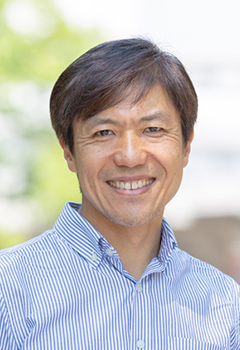Acting for Sustainability : A Legal Perspective
Feature #7 : Thinking Through Climate Change and Carbon Neutrality with Professor Emori
(Interview with Seita Emori, Professor, Institute for Future Initiatives, the University of Tokyo, and Senior Principal Researcher in the Earth System Division, National Institute for Environmental Studies.
Interview conducted by Wataru Shimizu, Partner at Anderson Mōri & Tomotsune)

| Issue | Aug 28, 2023 |
|---|

Lately, global-level issues and the UN’s 17 Sustainable Development Goals (SDGs) that indicate the goals for solving these issues have been drawing more attention. At Anderson Mōri & Tomotsune, we as legal professionals continue to look for ways to contribute to achieving these SDGs. Our lawyers have developed a wealth of SDG-related expertise in their respective fields and have put these resources at the disposal of our clients, helping them find best practice-based solutions to the many legal issues that attach to sustainable development.
In this special feature, we introduce some of the activities that have allowed our lawyers not only to commit our Firm to the UN’s SDGs, but also to position our Firm as a leader in the field of sustainability law.
In this feature, we interview Seita Emori, Professor, Institute for Future Initiatives at the University of Tokyo and Senior Principal Researcher in the Earth System Division, National Institute for Environmental Studies.
*Date of the interview: September 14, 2022, conducted online.
Feature #7: Thinking Through Climate Change and Carbon Neutrality with Professor Emori
(Interview with Seita Emori, Professor, Institute for Future Initiatives, the University of Tokyo, and Senior Principal Researcher in the Earth System Division, National Institute for Environmental Studies.
Interview conducted by Wataru Shimizu, Partner at Anderson Mōri & Tomotsune)
Table of Contents:
Q1:Why I chose to study climate change science
ShimizuThank you for accepting our interview. I have listened to one of your lectures in the past and have always wanted to hear more details. First, could you describe your work?
Mr. EmoriThank you for your invitation. I have been studying global warming for about 25 years at the National Institute for Environmental Studies in Tsukuba City, Ibaraki Prefecture. I have also been working at the Institute for Future Initiatives of the University of Tokyo since April, 2022.
When I first started my research, I was researching climate modeling that simulates future projections of climate change by using computers. Professor Shukuro Manabe, who received the Nobel Prize in Physics last year (2021), pioneered this research field about 50 years ago.
Since then, I have been adding to our knowledge of climate change science. At the same time, I have had many opportunities to argue with people who say that global warming is a hoax, and to participate in policy discussions, although I am not an expert in policies. When we listen to policy discussions on climate change, we can simply say that it tends to be a dichotomy between the environmentalist-camp and the economist-camp, and we can say that responding to climate change involves not only scientific issues but also social values and standpoints. Under such circumstances, I have been thinking about where I should stand and what I should say as a scientist.
ShimizuWhat made you become interested in climate change science?
Mr. EmoriI came across the issue of climate change when I was looking for the subject of my graduation thesis. It was around the time when the United Nations Framework Convention on Climate Change was adopted in 1992.
Going back further, when I was a sophomore in high school, there was an accident at the Chernobyl nuclear power plant. I did not understand the graveness of the accident, but since then, I became interested in the controversy of "are nuclear power plants safe or dangerous?", a debate which was broadcasted on TV in Japan. The issue of nuclear power plants is similar to that of global warming countermeasures, and tends to be a dichotomy between safety and danger, but both sides seem to have a point, because people standing in different positions have different goals. I didn't know what stance to take at the time, but when I was in high school and college, I vaguely thought that I wanted to become involved in big social issues related to science and to be able to express my opinion.
ShimizuVery interesting. At that time, climate change was not yet a hot topic, although it was already a cutting-edge academic field, is that correct?
Mr. EmoriThe first report of the Intergovernmental Panel on Climate Change (IPCC) came out in 1990. It was when I picked up a book explaining this report by a Japanese ministry. The IPCC report was also mentioned in a university lecture, and this was just at the time when the so-called Cold War was over and climate change was becoming the agenda of international politics.

Q2:What is climate change?
ShimizuGetting down to the topic for today, please describe for us briefly the problem of climate change.
Mr. EmoriClimate change and global warming originally have slightly different meanings, but when viewed as social issues, they are roughly the same. I believe that the climate change issue is grounded in the fact that human activities release a large amount of greenhouse gases into the atmosphere, which not only cause the global average temperature to rise over the long term, but also affect human society and ecosystems by changing rainfall patterns, raising sea levels, and decreasing ice.
ShimizuYou mentioned earlier that there are people who claim that climate change is a hoax. So, is climate change actually happening?
Mr. EmoriYes, if you look at global average temperature data, it's definitely been on the rise for the last 50 years or so. This is a unique rise over the last 2,000 years, perhaps longer, over the last tens of thousands of years, and it is clear that natural phenomena cannot explain it.
But, for example, some people may feel that typhoons are increasing, but if you look at the data, they are not increasing. Also, you may feel that strong typhoons are increasing in frequency, but the data shows that they are not clearly increasing. Depending on how you look at the data, it's not always easy to see the climate change problem. Still, there is no doubt that the long-term rise in temperature is due to human activity.
ShimizuGiven that the non-human caused cycle of glacial and interglacial periods is also a form of global climate change, how is the present situation different from that?
Mr. EmoriIt is very different. Changes in glacial and interglacial periods are caused by astronomical changes in the Earth's orbit and in the inclination of its axis, which change the amount of solar radiation that enters the Earth, causing the increase and decrease of ice. We are now in an interglacial period, so if the next glacial period comes, the ice must expand, but instead the ice is decreasing rapidly. Astronomical calculations suggest that the next glacial period will come in 50,000 years, if ever, and we are now in a long interglacial period. Even so, the average temperature in the world is now 1.1 °C higher than before the industrial revolution.
ShimizuSo the temperature is already rising.
Mr. EmoriYes. You may feel that 1.1 °C is not a big change, but that is not so. It is believed that there is a difference of about 6 °C in the average global temperature between glacial and interglacial periods. During the glacial period, not only Antarctica and Greenland but also Scandinavia and Canada get vast amounts of ice, with sea levels as low as 100 meters below where they are today. In other words, although the glacial period has a completely different climate, the difference in the average global temperature is only 6 °C between the glacial period and the pre-industrial interglacial period. Humans have already raised temperatures equivalent to 1/6 of that 6 °C since the Industrial Revolution. The Paris Agreement aims for a temperature increase of "well below 2 °C," which is like saying "let's keep it below 1/3 of the difference between glacial and interglacial periods." Right now, we are trying to limit the average temperature increase to 1.5 °C, which is 1/4 of the difference between glacial and interglacial periods.
When we look at changes in the earth’s climate from a long time scale perspective, where continents move and various living creatures flourish and perish, it is true that our climate has fluctuated greatly. However, it has been only tens of thousands of years since human civilization was created, or thousands of years in the case of modern civilization, so it can be said that in the stable climate of the present interglacial period, the average temperature of the world has been the highest it has ever been since agriculture began and since modern civilization began.
Q3:Causes and impacts of climate change
ShimizuIs CO2 the cause of climate change?
Mr. EmoriGreenhouse gases include methane and other gases as well as CO2, but CO2 accounts for about 70% of climate change, and CO2 will be the biggest issue in the future. There are many other things that need to be reduced, but reducing CO2 is the biggest challenge.
ShimizuHow do you know that greenhouse gases, especially CO2, are responsible for climate change? Is it because the increase in global average temperature after the Industrial Revolution is proportional to the increase in CO2 concentration?
Mr. EmoriNo, we know this even more scientifically. Now that scientists know what wavelength of infrared radiation CO2 molecules absorb and emit, they can calculate how much infrared radiation coming from the earth is absorbed and emitted, and how this infrared radiation is absorbed again and heat is transmitted, given the amount of CO2 that is present. This allows us to calculate, in principle, how much infrared radiation will return to the Earth's surface and how much the temperature will rise as CO2 increases. Manabe, who won the Nobel Prize in Physics, was the first to calculate this precisely.
ShimizuBecause CO2 is a greenhouse gas, it can be calculated much more scientifically than simply saying that if CO2 increases, the temperature rises.
Mr. EmoriExactly.
ShimizuYou mentioned earlier that the average temperature increase should be limited to 2 °C or 1.5 °C. What is the difference between 2 °C and 1.5 °C?
Mr. EmoriThe difference between 1.5 °C and 2 °C was not understood by the international community at the time of the agreement "to aim well below 2 °C, preferably 1.5 °C" stated in the Paris Agreement in 2015. The United Nations Framework Convention on Climate Change (UNFCCC) requested that the IPCC explain this better, because at the time it wrote this goal the difference was not well understood.
In response, the IPCC issued the so-called "1.5 °C Special Report" in 2018, in which it clarified the differences in impacts on human society and ecosystems between 1.5 °C and 2 °C, as well as the differences in the scale of measures required between 1.5 °C and 2 °C. This special report explains the difference between the effects of 1.5 °C and 2 °C. For example, (1) a 2 °C increase in average temperature will increase the number of people in the world who are poor and seriously affected by global warming by hundreds of millions more compared to 1.5 °C, and (2) a 2 °C increase will cause a loss of more than 99% of coral reefs in warm water, compared to 70 to 90% at 1.5 °C. Also, (3) it is said that, as of 2100, if the average temperature rise is held at 1.5 °C, sea level rise can be held down 10 cm lower than that at 2 °C. 10 cm doesn't seem like a big difference, but it is estimated that the number of people affected by sea level rise will vary from millions to tens of millions of people worldwide by this 10 cm difference. The special report led the world to believe that the average temperature increase should be kept at 1.5 °C.
ShimizuSo if we want to control the rise in temperature, it would be better for the rise to be as small as possible.
Mr. EmoriAnother important part of this discussion are the Tipping Points. Many of the impacts of climate change gradually increase in severity as the temperature rises, but it has been pointed out that there may be phenomena with thresholds that cause sudden impacts beyond a certain level. For example, there are scientifically predicted events above a certain temperature, such as where (1) the Antarctic ice sheet starts to destabilize and decline, and in the worst case, it starts to collapse, and (2) the Amazon rainforest starts to wither and die, and so on. We don't know exactly at what temperature such events will be triggered, but it is certain that the possibility of exceeding that level will increase by gradually increasing to 1.5 °C and 2 °C. It can be said that the belief that it is better to keep the temperature rise as low as possible stems also from this consideration of the Tipping Points. A recent paper suggests that even a temperature increase of 1.5 °C is reasonably likely to exceed several Tipping Points.
ShimizuSo there are some things that will obviously have an impact?
Mr. EmoriYes, above a certain temperature, the effects accelerate or become irreversible. If the temperature exceeds that level, even if the temperature rise stops, certain phenomena will continue to advance without stopping.
Q4:Decarbonization Initiatives (1) Energy that does not emit CO2
ShimizuUnder such circumstances, what kind of efforts are being made in the world?
Mr. EmoriWe need to reduce greenhouse gas emissions to stop climate change, but if we are to aim for a 1.5 °C cap, we need to achieve net zero emissions of CO2 globally by 2050. To achieve net zero emissions, we need to reduce the amount of CO2 emissions toward zero and the part that cannot be reduced to zero should be balanced by using methods such as absorbing them in forests and storing them in the ground. In other words, we need to realize a world in which no CO2 is produced by human activities. Emissions of methane other than CO2 must also be significantly reduced. Then we would finally be able to achieve a 1.5 °C cap.
Fossil fuels have the greatest impact on CO2 emissions. Modern society depends on fossil fuels for about 80% of its energy. In other words, modern society runs on energy generated while emitting CO2, but if we are to achieve 1.5 °C, we will have to change all energy sources to energy that does not emit CO2 in 30 years.
ShimizuAre CO2-free energy sources, for example, renewable energy and hydrogen?
Mr. EmoriYes, depending on weather conditions and time of day, renewable energy is already generating enough electricity in some areas.
As for hydrogen, the question of "from what to make hydrogen" is an issue like electricity, but I think many people are beginning to think that hydrogen will play an important role in the overall energy system in the future. This is because hydrogen may replace the source of power that cannot depend on electricity. In the first place, there are two types of energy systems: electric power and non-electric fuel. One possible way to achieve decarbonization is to electrify the non-electric parts and not generate CO2, for example, by using renewable energy or nuclear power. Even so, it is difficult to electrify long-distance transportation by truck, plane or ship, and the use of fuel will remain. And even if we have to supply energy as a fuel, from the viewpoint of decarbonization, we need a fuel that does not emit CO2. In that case, hydrogen, ammonia derived from hydrogen, and synthetic fuels, are strong candidates. Electrolysis of water is less efficient than using electricity directly, but it can produce hydrogen. Therefore, I think it is possible to create hydrogen by electrolyzing water using zero-emission electricity, and to use such hydrogen as fuel.
ShimizuCould hydrogen be used to supplement renewable energy?
Mr. EmoriYes, hydrogen can be used. As dependence increases on renewable energy, the amount of electricity generated fluctuates depending on weather conditions and other factors, and an adjustment mechanism is required to balance supply and demand. Currently, we are adjusting the amount of thermal power generation by increasing or decreasing it, but in order to achieve decarbonization, conventional thermal power generation cannot be used for adjustment. Of course, there is an option of using zero-emission thermal power generation but, for example, there is an option of using renewable electricity to produce hydrogen when there is an excess of renewable electricity, and using hydrogen when there is not enough renewable electricity. In any case, there is a possibility that hydrogen will play an important role in various ways in the future, and I think that the recent discussions on hydrogen are becoming more realistic.
Hydrogen technology is a field in which Japan is ahead, and in the context of decarbonization, Japan can be said to be leading the world and contributing to the world along with CCUS (Carbon dioxide Capture, Utilization and Storage) technology.
ShimizuSo hydrogen is important.
Mr. EmoriNot really. Speaking of the volume that contributes to decarbonization, it is important to have a large amount of renewable energy. However, discussions on renewable energy technologies are not very active in Japan, perhaps because there are few companies that manufacture renewable energy facilities. When it comes to decarbonization technologies, the role of hydrogen and CCUS is over-blown, and I think that more attention should be paid to discussions on the introduction of renewable energy on a large scale. I am also concerned that even if Japan leads in the development of hydrogen and CCUS technologies, it might lose out to other countries if it enters the phase of mass production. That was exactly what happened with solar panels.
ShimizuI see. From a technology perspective, I was concerned that the momentum for decarbonization might have waned following the invasion of Ukraine.
Mr. EmoriI'm not too pessimistic about that. For example, in light of the Ukrainian invasion, the European Commission announced the REPower EU, which aims to quickly shift away from Russian fossil fuels, and attempts are being made to achieve energy decarbonization while maintaining economic security. Rather, decarbonization may in fact accelerate.
ShimizuMany countries and regions have declared carbon neutrality by 2050, so decarbonization innovation is a must.
Q5:Decarbonization Initiatives (2) Emissions Trading
ShimizuIncidentally, do you think we can contribute to reducing CO2 emissions by promoting trade mechanisms such as carbon offsetting?
Mr. EmoriEmissions trading around the time of the Kyoto Protocol was a system that made me doubt whether it was really meaningful. At that time, emissions trading was conducted in such a way that Japan, for example, had an international obligation to reduce its CO2 emissions by 6%, and if it could not meet this obligation, it would have to pay for emission permits.
But not anymore. While the Paris Agreement sets an obligation to voluntarily set a goal and to make efforts to realize that goal, it in fact does not set an obligation to achieve that goal. The purpose of the Paris Agreement is to create a framework to cooperate with and encourage each other to mutually set higher goals and actively pursue the reduction of CO2 emissions together, instead of reluctantly and patiently working to reduce CO2 emissions.
ShimizuI see. That is very educational.
Mr. EmoriPersonally, I think carbon pricing, an instrument to capture the costs to be paid by the public for greenhouse gas emissions, is an essential and effective policy to address climate change. Emissions trading and carbon tax are two ways to price carbon, but to simply conduct trading does not make much sense. In order to link emissions trading to decarbonization, it is important to trade with a cap. This is because the cap will be achieved in the most economical way by trading.
ShimizuWhat about a carbon tax?
Mr. EmoriYes, we could return a carbon tax revenue to the public in some form. If, for example, tax revenue is simply returned in equal shares while maintaining tax neutrality, a system can be created in which higher CO2 emissions result in higher taxes, while lower CO2 emissions result in lower taxes. Generally speaking, people are reluctant to pay taxes, but I believe that by devising smart ways to use tax revenues, we can encourage the development of industries that generate as little CO2 as possible, and create a cycle in which products and services that do not generate CO2 have a relative price competitiveness that will attract investment.
ShimizuSo the key is to link carbon pricing to changes in industrial structure.
Mr. EmoriThe obstacles for decarbonization vary by industry. For example, the obstacles to decarbonization in the manufacturing industry are high, while those in the IT and financial industries are low, meaning that "decarbonization should be pursued more and more" and that "there is a business opportunity." Global challenges will not be solved unless we change the direction in which we can positively tackle decarbonization even in industries with high barriers to decarbonization, such as the manufacturing, energy, and materials industries. Even in industries that are reluctant to address decarbonization, I think the key is whether we can make changes that we really want to make.

Q6:What We Can Do
ShimizuAs individuals, what can we do about climate change?
Mr. EmoriYes, it's a common question in the context of what each citizen can do. I always respond that it is important to be interested in the social system and speak out about the system.
Of course, it is important to save electricity frequently, refrain from excessive settings of air conditioners, carry reusable bags, and travel by bicycle. However, the effects of such activities are limited, and the time required to respond to climate change issues is limited. Therefore, it is necessary to change society so that no CO2 is produced even when we are not consciously thinking about it. Even if we rely on individual efforts, we will never be able to reduce CO2 emissions to zero, so the system must change. This requires everyone to be interested in systemic issues and to speak up about them.
ShimizuThat is very convincing.
Mr. EmoriThere's been a very good development recently in terms of having citizens speak up for systemic change. In June 2022, the Diet passed the Amended Building Energy Efficiency Act (Act for Partial Revision of the Act on Improvement of Energy Consumption Performance of Buildings to Contribute to the Realization of a Decarbonized Society), which mandates insulation standards for new buildings essential to global warming countermeasures. There seems to have been strong resistance to this amendment and it has been procrastinated, so there was a possibility that it would not be discussed in the recent Diet session. To prevent this, citizens raised their voices and carried out signature campaigns, and citizens expressed their opinions to local elected representatives and made them listen to experts, and in the end, the bill was passed very quickly. The bill might have been passed even if citizens did not act, but I think participants in this process felt empowered. Such successful experiences are important, and each time something like this happens, more people are motivated to express their opinions, and the circle of people who experience this will expand to include more people. I think these are very important things that each citizen can do.
ShimizuExpressing opinions is also an important change in action to solve the climate change problem.
Q7:Future Activities
ShimizuFinally, do you have any future goals?
Mr. EmoriIt was a valuable experience for me to appear as a witness for the plaintiffs in a lawsuit to stop coal-fired power generation in Kobe. I would like to continue to think about this issue in such a grassroots way. I would also like to study communication issues at the University of Tokyo, such as how climate change is perceived in the media and how people perceive climate change based on media reports.
I also see that there are new and interesting aspects arising in the discussions on the large-scale introduction of hydrogen and renewable energy as decarbonization technologies, where there should be discussions not only on technical and economic issues such as costs and potential, but also on ethical issues such as fairness and distribution, which are values that have not been explicitly discussed until now. I am proceeding with research presently to see if we can somehow approach these issues from such a new angle.
ShimizuYes, people in vulnerable positions are exposed to greater climate change-related risks. So we need to pay attention to the ethical aspects of climate change as well. Thank you for your time today.

Seita Emori






